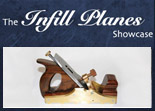A Brief History Of The Woodworking Plane
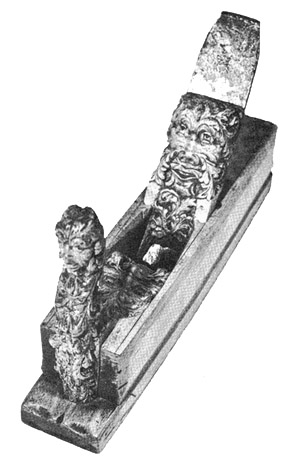
NOTE: The following article is from a small booklet by Stanley Tools in Great Britain which was printed sometime in the 1950’s or 1960’s.
A Brief History Of The Woodworker’s Plane
For almost 2,000 years the plane has been one of the craftsman’s most important tools. It has helped to shape history, but its origins are unknown.
In the earliest times wood was probably roughly trimmed with an adze and then smoothed with a stone, using sand as an abrasive. This method was the one most probably used by the Ancient Egyptians, skilled woodworkers who were familiar with the mortice and tenon joint.
The first plane was probably a chisel-like tool inserted in a block of wood, but none of these rudimentary tools has come to light. By Roman times, however, great developments had taken place.
The earliest known planes date from 79 A.D. and were found at Pompeii. Any schoolboy would recognise them as planes. Except for the rather narrow iron, the dimensions agree very closely with those of the present No. 3 Smoothing Plane.
The Pompeii planes had a wooden case sheathed with an iron plate about 1/4” thick. The mouth was cut about a third of the way back from the front, and the iron, set at an angle of about 50 degrees, was held with a wedge against a round iron bar across the opening. A grip for the right hand was effected by cutting a slot through the wooden core.
The earliest plane found in Britain was excavated at Silchester. This was a Roman iron plane of much sturdier construction than the Pompeii models. Roman planes of Bronze without the use of wood have also been found on the Continent.
The Silchester plane bears a remarkable resemblance to a modern Jack Plane in its main lines of design.
Other discoveries indicate that this pattern remained in fairly constant use for at least l50 years.
With the passing of the Roman Empire the picture again becomes blurred until the Middle Ages. A painting by Bourdichon of a Parisian joiner’s shop of about 1510 shows a late medieval tryplane and smoother and the artist’s great attention to detail helps us to discover a great deal about the tools of this period.
The front of the plane is fitted with a carved handle for the left hand and the back of the stock is left flat.
During the first half of the 15th century the traditional method of securing the plane iron by means of a wedge bear
ing against a cross bar, which had been in use since Roman times, was superseded by a grooved wedge.
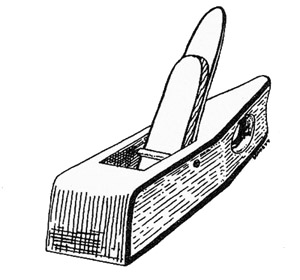
The first accurately dated example of the new patterns is seen in another picture, Durer’s famous engraving ‘Melancholia’, dated 1514. The smoothing plane shown still had the rather small mouth opening, while the grooves for the wedge were comparatively deep.
Another new feature, the stopped chamfer along the top edge, gave a more comfortable grip, and both these features remained on wooden planes until modern times.
Generally speaking the planes ofthe 15th, 16th and 17th centuries were provided with a forward horn. This disappeared in England but has persisted in Europe to the present day, where it is often the practise to use the plane with a pulling rather than a pushing action.
This was the craftsman’s ‘Golden Age’ and much time and trouble was taken over the design of tools. Craftsmen were being called upon to do more skilful and exacting work and the use of tools and the interest in development had become very widespread.
A cabinet maker’s plane of the 17th century has been preserved and has beautifully finished scrolls and the toe and heel are so designed that it is impossible to trap the fingers. Some exquisite carving can be seen on a set of early German planes in the possesion of the Weston Park Museum, Sheffield.
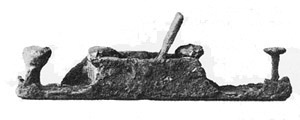
It is worth noting that except for the lower pitch of the iron. development took place on a close parallel with that of Roman times. The first step was iron sheathing (like that of the Pompeii planes discovered later). Dated from 1880 a plane found in the U.S.A. had a wooden core sheathed in iron, with a low set cutting iron and a very narrow mouth. It was no doubt ideal for the shooting of mitres and end grain and for smooth finish for difficult grained wood.
Believed to have been made in England, this plane was the forerunner of many similar types. Blade fixture was by wedge and of such a form that the blade could be removed without banging the blade on the bench.
Other planes of the early nineteenth century have survived, in which a sheathing of iron is used and in some cases this was dovetailed together.
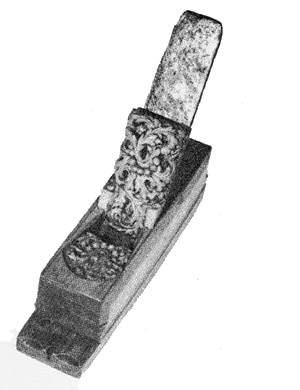
From 1800 onwards many planes trace their origin to Shefiield and London as the craft of the toolmaker had now begun to develop and centre on these places.
Experiment continued. Bronze was used (as it was in Roman times) for plane bodies but mostly in smaller planes such as bull nose and shoulder planes. More accuracy of sole and mouth was the goal and it was not long before cast iron was used to attain this.
Although experiments with planes with cast iron soles were taking place as early as 1827, it was not until about forty years later that a satisfactory tool was marketed. The man responsible for much of this development was an American, Leonard Bailey of Boston, Mass.
The story of the gradual evolution of American metal planes of the Stanley type is rather hazy although a fairly accurate pattern of development can be obtained from old catalogues and patent specifications. Even so, some of the more important improvements to planes were not made the subject of patents at all.
As mentioned above the first glimpse of a metal soled plane seems to have been in 1827 when a patent was taken out by H. Knowles for a plane with a cast iron sole. This would seem to have been a Jack plane with a flat sole. The side plates rose to their maximum height about one third of their length from the front Two ribs on the inside formed a groove to take only a single iron and a wooden wedge. At the back was a closed handle with a turned knob at the front.
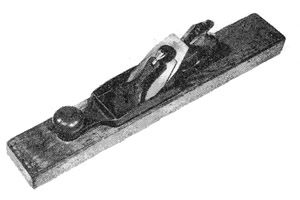
This precarious and rather primitive arrangement must have been most dillicult to adjust for in 1843 a man named W. Foster patented an improvement, for regulating shaving thicknesses without using a hammer. This was done by means of a block let into the sole just in front of the cutter and adjusted vertically by a screw. Even today this is occasionally seen with Continental planes but has never been very popular with craftsmen because it reduces the effective area of the plane sole contacting the wood.
It was in 1854 that a screwed clamp was introduced to secure the iron instead of the wedge. This was done on the same cast iron stock with slightly curved plates more like the later Stanley planes.
This was the stage of development when Leonard Bailey made his entry into the world of planes. His earliest efforts were directed at planes with wooden soles. His first patent, taken out on June 22nd, 1858, dealt with a friction plate device for the vertical adjustment of the cutter of a joiner’s plane.
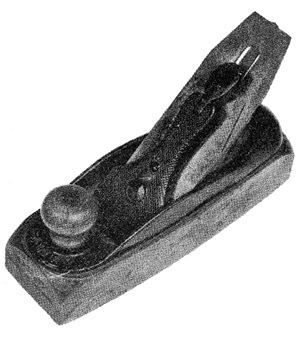
This proved to be ineffective and little more was heard of it. This patent also dealt with a cammed lever cap with a spring at the back which has since been a feature of the later Stanley and Bailey planes and has been retained to this day.
In August of the same year he took out a second patent which was specifically concerned with the cammed lever cap of his earlier patent.
The next nine years saw considerable progress in Bailey’s ideas. ln his patent of 1867, described simply as a ‘Bench Plane’, the wooden stock was still a feature but a shallow boat-shaped casting was attached to the top to give a solid base for the plane iron. The only feature retained from earlier designs was a metal seating for the screw fastening the lever cap.
The apparent subject of this patent was the vertical nut and forked lever engaging in the slot in the cap iron and providing the cutter with a positive vertical adjustment. Two handles were attached to the casting, fore and aft, and the wooden stock had rounded ends and was chamfered along the top.
One of Bailey’s real contributions to progress was included in this model. This was the comparatively thin cutter with paralleled faces. All the cutters used in previous patterns were standard Jack or Smoothing plane irons, which tapered in thickness from the cutting edge to the top.
A thin paralleled iron was an immense improvement over this because it could be kept sharp more easily by honing only.
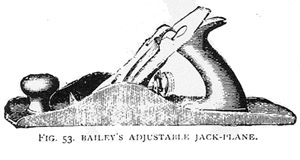
Some short time later the adjusting nut was turned to the horizontal position, as it is today, and the forked lever was reversed to suit. In earlier patterns the knob at the back was cut away to make room for the nut. However, when it was turned the other way there was so little clearance that the back knob was removed altogether and the end of the casting was rounded to give a more comfortable grip. Bailey also provided a handle smoother 9″ to l0″ long and a ‘Jenny’ plane 13″ long with a Jack plane handle bedded on a stepped casting. This gave more room for adjusting the nut.
The Jack, Fore and Jointer planes had a flat casting screwed to a long, paralleled-sided stock, with an open grip and a turned knob for the left hand.
These three planes also show in their earliest forms another important feature of Bailey’s tools which played a big part in future development and popularity. This was the standardisation of components, which of course made it possible to make and sell the planes at popular prices and also enabled craftsmen to obtain spare parts more easily. Apart from the stocks and the corresponding castings all the parts for the various sizes of cutter used, were identical and interchangeable.
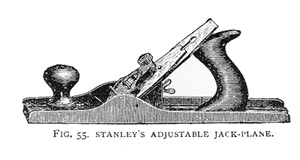
So far efforts had been concentrated on improving the wooden soled plane by incorporating a metal seating for the cutter and working parts. The final important step in the development of the modern plane now had to be taken, the transition to an all metal bodied plane which would give a sole of greater and more lasting accuracy. The Knowles cast metal sole mentioned earlier was slightly modified and a separate adjustable bed or frog was provided. This made it possible to vary the mouth opening. Most of the other standard components, including the cap lever and the forked adjusting lever developed on the previous wooden stocks, were incorporated in the new design. In fact apart from one feature added some years later it is very similar to the present day version of the plane.
At this time, about 1869, Bailey was engaged in the manufacture of his planes in a very small way in Boston, Mass., but he sold his business and most of his patents to the Stanley Rule and Level Co., of New Britain, Conn. He was subsequently appointed as head of their plane department and the firm later became known as Stanley Tools.
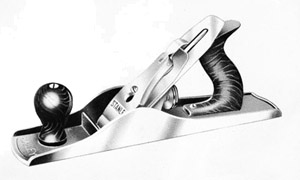
Bailey’s chief claim to distinction was that he saw clearly the desirability of a thin steel cutter of uniform thickness which could be kept in condition longer by honing only and whose original bevel could therefore be more easily maintained. He was the first man to invent a plane in which such a cutter could be used to advantage with adequate and fine adjustment, and later to incorporate them in an all metal plane.
Bailey was the father of the modern plane which is now a precision cutting instrument capable of removing the finest shavings.
Although his patents long since expired and his ideas have been so extensively copied as to have become standard designs the Stanley company still retains the name Bailey on all its bench planes in acknowledgement of his great contributions to the development of the plane we know today.
He put accuracy into the hands of craftsmen all over the world and put skill into the hands of thousands of amateur enthusiasts who find relaxation and a sense of achievement in making things. 
Published and printed in England by Stanley Works (G.B.) Ltd., Rutland Rd., Sheffield 3.
Last Updated:






